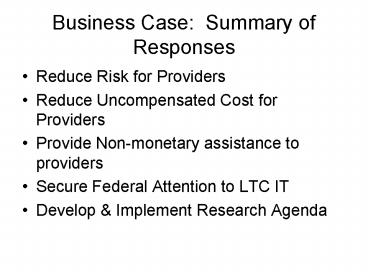Business Case: Summary of Responses - PowerPoint PPT Presentation
1 / 15
Title:
Business Case: Summary of Responses
Description:
Business Case: Summary of Responses. Reduce Risk for Providers ... Implementation guides. Participate in Standard-Setting Activities ... – PowerPoint PPT presentation
Number of Views:21
Avg rating:3.0/5.0
Title: Business Case: Summary of Responses
1
Business Case Summary of Responses
- Reduce Risk for Providers
- Reduce Uncompensated Cost for Providers
- Provide Non-monetary assistance to providers
- Secure Federal Attention to LTC IT
- Develop Implement Research Agenda
2
Reduce Risk for Providers
- Certification
- Interoperability Standards
3
Reduce Uncompensated Cost
- Incentive Payments
- Insurors
- Medicare (P4P)
- Demonstrating Use e.g. ability to produce patient
summaries - Doing something Clinically Appropriate
- Federal Government Tax credits, Loans, etc. for
early adoption - Direct re-imbursement of costs from Medicaid
(100 allowable, classify as nursing cost)
4
Provide non-monetary Assistance to Providers
- Make available information on available loans and
grants - Develop strategies for small providers to
collaborate - Methods for providing on-going support (eg QIOS)
5
Secure Federal attention to LTC
- Make LTC IT a National Priority
- Get parity for LTC in dollars
- Proportional to LTC share of Federal health
spending - Formalize a LTC HIT organization to provide
information and advocacy
6
Secure Federal attention to LTC
- Make LTC IT a National Priority
- Get parity for LTC in dollars
- Proportional to LTC share of Federal health
spending - Formalize a LTC-IT advocacy organizatio to
develop/implement case strategy
7
Develop Implement a Research Agenda
- Compile Industry Data on ROI and Efficacy
- Determine benefits to consumers
- Develop standardized work processes culture
change steps so savings can be realized - Develop a way to share costs and benefits across
the continuum - Disseminate widely outcome data from
e-prescribing pilots - Develop appropriate P4P measures that providers
can support
8
Top Five Actions
- Develop Adopt Standards (reduce risk)
- Product/Vendor Certification (reduce risk)
- P4P for HIT use (federal other payors)
- RD still needed for P4P for quality
- Benchmark pilots, demonstrations, early adopters
of EHR/E-prescribing - Formalize a collaborative approach to LTC HIT
Advocacy (standards policy)
9
Healthcare Standards PanelResults
- LTC HIT SummitAugust 23, 2005
10
Promote Awareness Involvement
- Identify key organizations and monitor
- Publish list of important/relevant standards orgs
- Advocacy
- Involve providers-types, clinicians (including
physicians, nurses, assessment coordinators) - Monitor activities and involvement
- Implementation guides
11
Participate in Standard-Setting Activities
- LTC Representation in the following
- HL7
- X12
- NCPDP/e-prescribing
- EEE1073
- LOINC
- SNOMED
- Priorities Data content and Interoperability
12
Data Content
- Standardized data content across care settings
and develop standards for LTC - Data format
- Data definitions
- Standardized transfer of care data content
- Acute to SNFSNF to Acute
- Decide on tool to be used (CCR or other) and map
integrate content - Determine how to implement and assure use
13
Timeline
- 2 to 5 year timeline
- Within 2 years e-prescribing
- 2-3 years standardization
- Full functioning EHR
- 3 5 years
- Outlier 5-10 years (ready for boomers)
14
Quality and Innovation
15
Five Top Action Items
- Work with QIOs and ALL members of the Community
of LTC to develop models, templates on disease
management based on research. - Develop and implement standards, processes to
allow accurate clinical information flow between
care settings. - All systems have to be holistic to the persons
disease stage an d not to just one disease. - Integrate HIT systems to measure quality outcomes
for programs like pay for performance. - Develop workflow and processes that assist care
givers in developing trends and clinical pathways
to quality of care and life.































